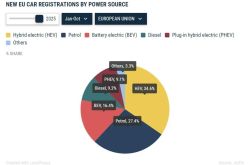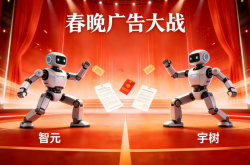Vertical AI leads the industry explosion! AI is finally starting to solve real-world problems
![]() 03/14 2025
03/14 2025
![]() 476
476
Recently, a product named Manus has sparked controversy.
What is Manus, and why has it suddenly become popular? Judging from the demos displayed on its official website, Manus focuses on practical applications for specific scenarios, such as providing in-depth product experiences and generating research reports, or batch processing interview resumes and ranking them based on scores.
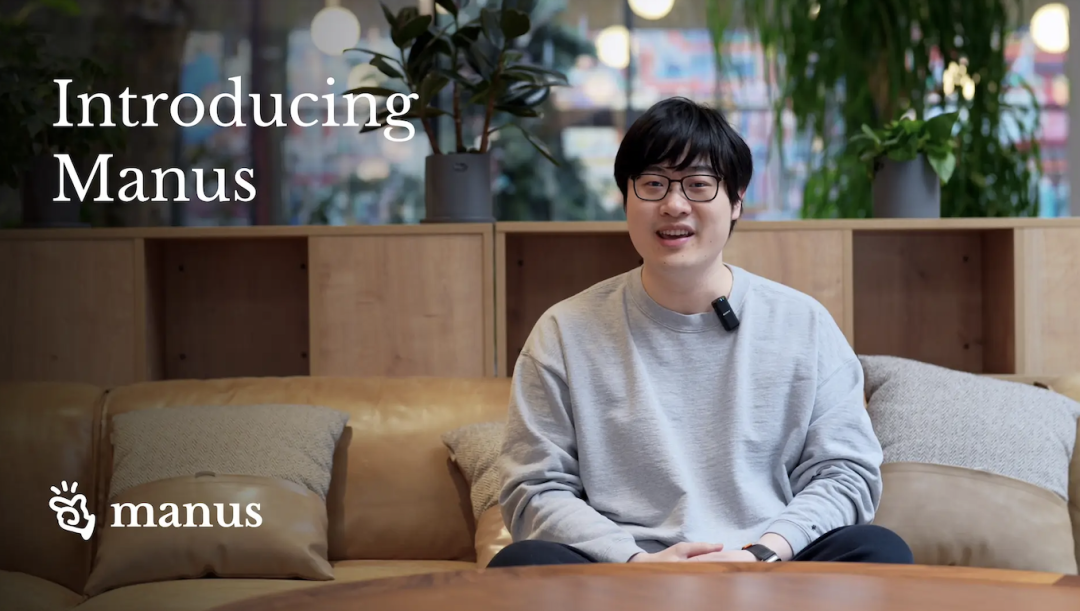
Source: Manus Official Website
Regardless of the controversy surrounding Manus, its ability to cause a stir online precisely illustrates a new trend in the AI field: AI development is no longer blindly pursuing scale, but instead beginning to delve into practical value.
Coincidentally, shortly after the emergence of Manus, OpenAI followed suit with a major move, introducing a developer toolchain to simplify agent development and assist developers and enterprises in building useful and reliable AI agents. OpenAI's Chief Product Officer Kevin Weil bluntly stated, "2025 will be the year when agents truly come into their own. By 2025, ChatGPT will start doing things for you in the real world."
This also reveals a fundamental change in the AI field: in the past, AI pursued general, wide-ranging capabilities, but now it is more focused on solving specific problems in particular vertical fields.
The focus of the AI field is shifting, and the market is beginning to focus on vertical applications
This development path is not surprising. Historically, changes in the technology industry often follow certain phased patterns. Taking the internet era as an example, initially, those who "empowered" others benefited, such as semiconductor companies. Then came the infrastructure layer, including enterprises related to cloud computing, devices, and power supply. Finally, it was the application and service layer, such as Douyin, WeChat, and Meituan, where most of the value was released after application promotion.
This same logic applies to the AI era. General large models establish the infrastructure, and it is the vertical models derived from these general large models that ultimately realize the true value of AI.
Two scenarios can fully demonstrate this: one is the medical industry, and the other is the translation industry.
Although artificial intelligence has been implemented in various medical scenarios, there is still a significant difference between specialized vertical models in the current medical field and general large models represented by DeepSeek. Taking drug discovery as an example, according to Xinhua Finance, many biopharmaceutical companies have stated that the current direct enabling of drug discovery by general large models is still limited.
Drug discovery currently still relies on vertical models. The difference between general and vertical models primarily depends on two aspects: the difference in training data sources and the difference in feedback mechanisms. The available data for general models is vast and easily accessible; the data used for specialized model training has higher quality requirements and is precise.
Taking the AI translation market as another example, it is undeniable that for simple translation needs such as text translation, large models can generally meet the requirements. However, for translations with professional difficulty and low fault tolerance, we tend to have greater doubts about large models. The cost of trial and error is too high in terms of accuracy, professionalism, and safety compliance, so ultimately, we still need to resort to professional tools.
Even a powerful model like DeepSeek sometimes engages in "emergent thought" in its response results, potentially resulting in the invention of new concepts in text, the stacking of nouns, and the abuse of rhetoric. Simply put, it can be overkill. This unilateral "optimization" of a certain word is fatal in professional scenarios, especially in important situations or medical translations, where the cost of errors is too high.
Moreover, DeepSeek sometimes fabricates information, especially when giving examples, where it is prone to wild imaginings. The following example is indeed ridiculous.

Source: DeepSeek
In professional fields requiring precision, the "emergent capabilities" that general large models pride themselves on can instead become sources of risk. When technology enters the stage of practical industrial application, establishing precise data and scenario adaptation is more meaningful than simply increasing model parameters.
Therefore, a major trend we can now observe is that the market focus will shift to vertical AI applications in 2025.
For professional tools looking to embrace AI, vertical models are the best choice
If the protagonist of 2024 was the general large model, then the protagonist of 2025 will undoubtedly be the vertical model with small parameters.
While the industry is still heatedly discussing the reconstruction of the AI ecosystem by the DeepSeek-R1 open-source strategy and continuously exploring the technological breakthroughs of the Manus intelligent agent, domestic large models have achieved a crucial leap in vertical tracks.
On March 11, NetEase Youdao announced the completion of an iteration of its underlying translation technology. Based on its independently developed Ziyue Translation Large Model 2.0, it achieved translation quality surpassing mainstream general large models both domestically and internationally, ranking first in the industry.
We also conducted a practical test and found that in many professional field translations, Youdao's large model translation indeed leads the mainstream general large models on the market.
For example, when inputting: "After the 52-week trial period, patients entered a 12-week follow-up safety period during which they were no longer receiving dupilumab or placebo." and comparing the translation results.

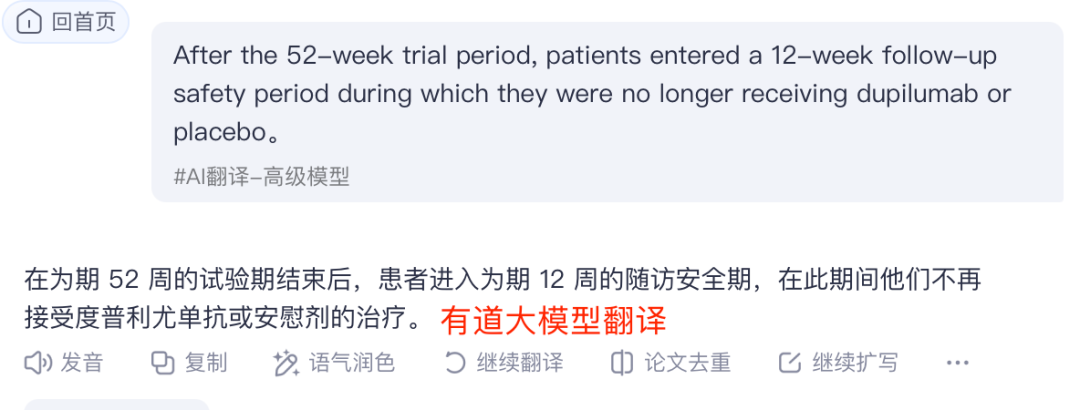
As can be seen, DeepSeek fails to translate "dupilumab" locally and still presents it in English, while Youdao Dictionary accurately translates "dupilumab" as "dupilumab".
Additionally, DeepSeek translates "trial period" as "treatment period," while the correct translation should be "trial period" as provided by Youdao Dictionary.
I'm not sure what the difference between "treatment period" and "trial period" is in a medical context, but semantically, the two are obviously misleading for non-medical professionals.
There are many similar examples. For instance, a general large model once mistranslated "placebo effect" in a clinical trial report as "pleasure effect." In an arbitration case, "force majeure" in a legal document was translated as "major force." Another example is the translation of "joint and several liability" in a merger and acquisition agreement as "joint and separate liability," leading to a significant misunderstanding between the parties regarding the scope of responsibility and ultimately requiring intervention by human lawyers for correction.
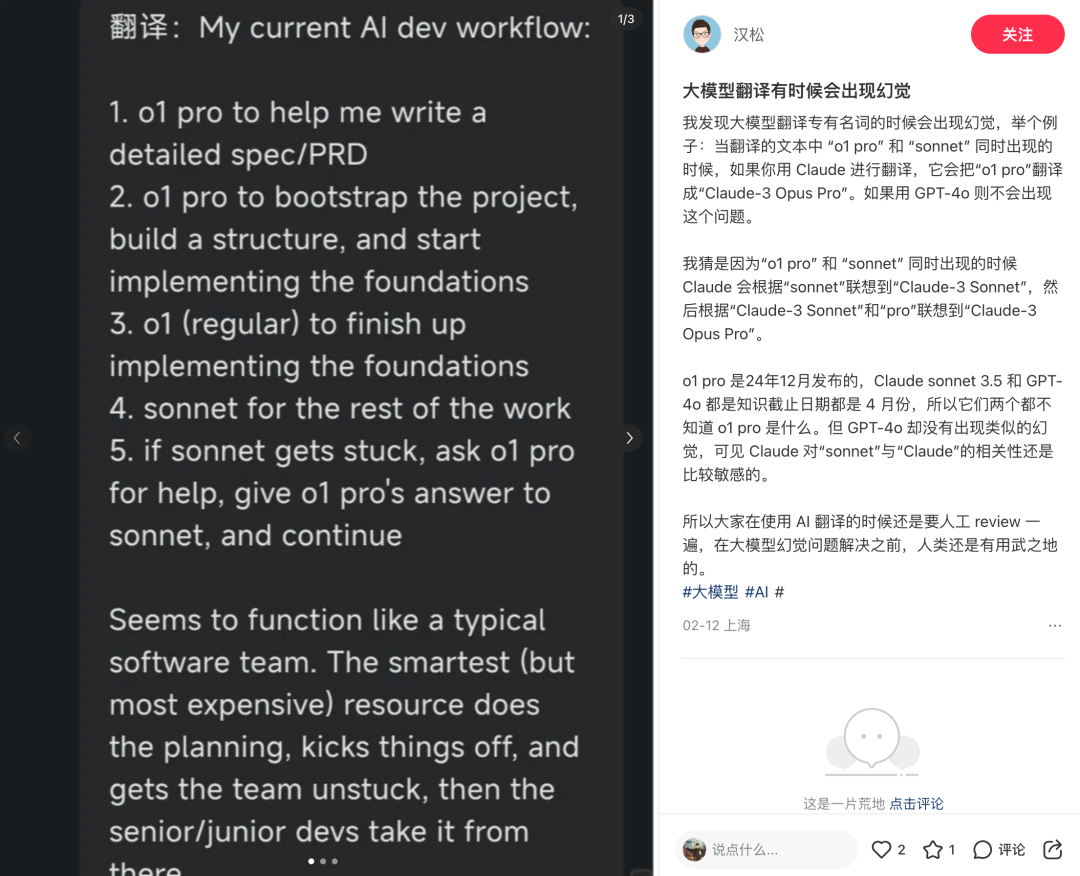
Source: Xiaohongshu
The reason why Youdao's large model translation quality can surpass that of mainstream general large models is driven by the vertical large model.
In July 2023, NetEase Youdao launched China's first educational large model, "Ziyue." The "Ziyue" large model was positioned from the outset as an educational vertical large model with "scenario priority." Compared to general large models, the educational vertical large model Ziyue possesses more specialized pre-training corpora, satisfying users' learning needs in different scenarios.
Currently, the Ziyue Translation Large Model has entered its 2.0 stage. Behind this, Youdao has conducted comprehensive optimization and upgrades from three core aspects: data, algorithms, and effect evaluation.
At the data level, Youdao meticulously collected and strictly cleaned tens of millions of high-quality translation data, which were then multidimensionally annotated by an expert team composed of English professional level 8 certified personnel and professional translators to ensure the high quality of training data. This greatly enriches the data resource library, allowing the model to excel in diverse translation scenarios.
At the algorithm level, Youdao's Ziyue Translation Large Model has achieved two major technological breakthroughs: large model fusion and Online DPO.
Simply put, large model fusion is like "expert consultation" for translation, equivalent to Youdao's Ziyue Translation Large Model assembling a "general expert team." By using large model fusion technology, it combines the advantages of different large models to avoid the phenomenon of catastrophic forgetting, ensuring that the model maintains its translation capabilities while also retaining comprehensive abilities.
Online DPO can be understood as a "cultivation plan" in the translation world. Each training generates two translations, one superior and one inferior, allowing the model to learn from the higher-quality translation. Through a three-round comparison and elimination mechanism, the model's judgment is strengthened, and translation preference data is automatically annotated. After three rounds of rigorous screening—preliminary selection, advancement, and finals—only "all-round translators" remain.
At the evaluation level, the Youdao team manually annotated development sets and blind test sets covering various fields, strictly ensuring the comprehensiveness and representativeness of the test data. The development sets and blind test datasets used by the algorithm team are strictly separated and independent of each other to ensure the objectivity and accuracy of the evaluation, with the final model effect based on the blind test set results.
In terms of automatic evaluation, Youdao not only uses the industry-standard Comet metric but also independently developed a more precise large model evaluation tool, further enhancing the reliability of translation quality inspection. At the same time, a more comprehensive manual evaluation scheme was designed and implemented to meticulously analyze and evaluate the model's translation results from multiple dimensions.
It is through these three levels of comprehensive optimization and upgrade that Youdao is able to achieve translation quality surpassing that of general large models with a small parameter model. And such stories will emerge more frequently in 2025.
The value of AI lies in how many practical problems it solves
The core of technological development is to solve problems. Now everyone is increasingly clear: by 2025, AI tools in various professional fields will usher in a major explosion.
According to the latest report by market research firm MarketsandMarkets, the market size of vertical AI applications is expected to expand significantly from $5.1 billion last year to approximately $47.1 billion by 2030, potentially exceeding $100 billion by 2032.
Against this backdrop, professional translation tools represented by Youdao have benchmark significance. The greatest enlightenment that this vertical AI revolution brings to the industry may lie in re-recognizing the essence of technology: the value of AI does not lie in the number of parameters, but in how many practical problems it solves.
While tech giants are still vying for a spot in the "trillion-dollar club," those like Youdao who are quietly cultivating in vertical fields are leveraging more sophisticated models and more focused investments to leverage practical value hundreds of times greater than that of general models. This "less is more" strategy may be the true compass for navigating the AI era.
Looking back from the technological watershed of 2025, we will discover an interesting phenomenon: while general large models attempt to conquer the world with scale, professional tools are redefining boundaries with depth. Among them, Youdao's large model translation is an excellent example of combining AI with practical applications.
This is not only a victory for technology but also a profound reverence for industrial laws: in any field, professionalism is always an irreplaceable scarcity.
Source: Lei Technology
Images in this article are from: 123RF Licensed Image Library Source: Lei Technology





